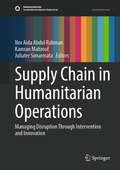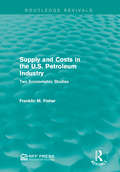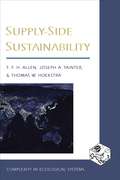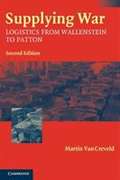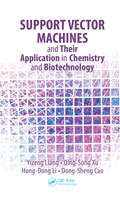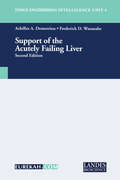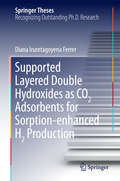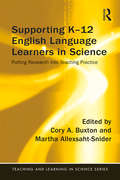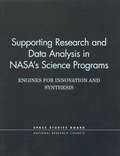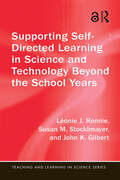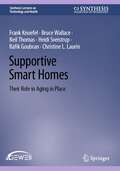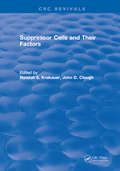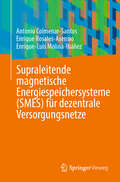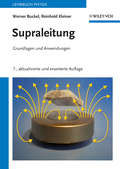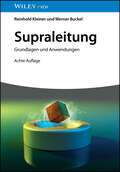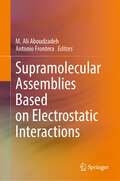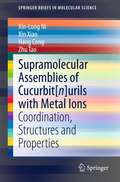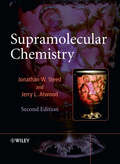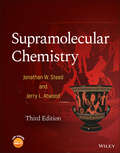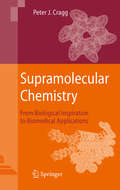- Table View
- List View
Supply Chain in Humanitarian Operations: Managing Disruption Through Intervention and Innovation (Sustainable Development Goals Series)
by Nor Aida Abdul Rahman Kamran Mahroof Juliater SimarmataThis book explores the pivotal role of humanitarian logistics and supply chain management in ensuring effective response and relief efforts during crises. It delves into the technology revolution in this field, covering emerging trends and providing in-depth knowledge on theories and applications. The book emphasizes how technology can enhance the efficiency of humanitarian logistics and supply chain operations, integrating and optimizing technology for effective aid delivery during emergencies or crises. This book highlights the vital role that humanitarian logistics and supply chain management play during crises, emphasizing recent technological advancements. It explores the key components, challenges, and innovations that enhance the effectiveness of these systems in providing timely and targeted assistance. The book also connects humanitarian logistics to several Sustainable Development Goals (SDGs), demonstrating how these efforts contribute to poverty alleviation, health, and disaster resilience. This book offers a blend of comprehensive research and high-quality outputs from reputed authors and editors. It targets doctoral, postgraduate, graduate, and final-year undergraduate students in aviation, logistics, transport, travel, and tourism studies, as well as managers and decision-makers worldwide.
Supply Network Dynamics and Control (Springer Series in Supply Chain Management #20)
by Dmitry Ivanov Alexandre Dolgui Boris SokolovThis book provides a comprehensive overview of recent developments in network dynamics and control with applications to supply chains, manufacturing and logistics systems. It systemizes these developments in the form of new taxonomies and methodological principles to shape the research domain of supply network dynamics control. Uniquely, the book links the fundamentals of control and system theories and artificial intelligence with supply chain and operations management. It addresses the needs of researchers and practitioners alike, revealing the challenges and opportunities of supply chain and operations management by means of dynamic system analysis.
Supply and Competition in Minor Metals (Routledge Revivals)
by David B. BrooksAn interest in the minor metals – termed "minor" as their annual production is relatively small – had been developing for many years. This study, first published in 1965, examines patterns of supply that can be identified as underlying the production of minor metals, and then uses these patterns to investigate the nature and degree of competition in the production of minor metals. This book will be of interest to students of environmental studies.
Supply and Costs in the U.S. Petroleum Industry: Two Econometric Studies (Routledge Revivals)
by Franklin M. FisherAny discussion of the various facets of petroleum policy in the United States rests to a greater or less extent on the issue of sensitivity of petroleum exploration, and hence of new petroleum discoveries to economic incentives. Indeed, a principle argument in favour of having a special petroleum policy at all is that domestic petroleum exploration is so sensitive to economic considerations that in the absence of special incentives exploration expenditures would sharply decrease, as would the amount of petroleum discovered; consequently, the nation’s known oil resources would be reduced to an extent dangerous in the event of an international crisis. This study attempts to answer the question: how sensitive are new petroleum discoveries to economic incentives? This book will be of interest to students of environmental studies.
Supply-Side Sustainability
by Joseph A. Tainter Thomas W. Hoekstra Timothy F. AllenWhile environmentalists insist that lower rates of consumption of natural resources are essential for a sustainable future, many economists dismiss the notion that resource limits act to constrain modern, creative societies. The conflict between these views tinges political debate at all levels and hinders our ability to plan for the future.Supply-Side Sustainability offers a fresh approach to this dilemma by integrating ecological and social science approaches in an interdisciplinary treatment of sustainability. Written by two ecologists and an anthropologist, this book discusses organisms, landscapes, populations, communities, biomes, the biosphere, ecosystems and energy flows, as well as patterns of sustainability and collapse in human societies, from hunter-gatherer groups to empires to today's industrial world. These diverse topics are integrated within a new framework that translates the authors' advances in hierarchy and complexity theory into a form useful to professionals in science, government, and business.The result is a much-needed blueprint for a cost-effective management regime, one that makes problem-solving efforts themselves sustainable over time. The authors demonstrate that long-term, cost-effective resource management can be achieved by managing the contexts of productive systems, rather than by managing the commodities that natural systems produce.
Supply-Side Sustainability (Complexity in Ecological Systems)
by Timothy Allen Joseph Tainter Thomas HoekstraWhile environmentalists insist that lower rates of consumption of natural resources are essential for a sustainable future, many economists dismiss the notion that resource limits act to constrain modern, creative societies. The conflict between these views tinges political debate at all levels and hinders our ability to plan for the future.Supply-Side Sustainability offers a fresh approach to this dilemma by integrating ecological and social science approaches in an interdisciplinary treatment of sustainability. Written by two ecologists and an anthropologist, this book discusses organisms, landscapes, populations, communities, biomes, the biosphere, ecosystems and energy flows, as well as patterns of sustainability and collapse in human societies, from hunter-gatherer groups to empires to today's industrial world. These diverse topics are integrated within a new framework that translates the authors' advances in hierarchy and complexity theory into a form useful to professionals in science, government, and business.The result is a much-needed blueprint for a cost-effective management regime, one that makes problem-solving efforts themselves sustainable over time. The authors demonstrate that long-term, cost-effective resource management can be achieved by managing the contexts of productive systems, rather than by managing the commodities that natural systems produce.
Supplying War: Logistics from Wallenstein to Patton
by Martin Van CreveldWhy did Napoleon succeed in 1805 but fail in 1812? Could the European half of World War II have been ended in 1944? These are only two of the many questions that form the subject-matter of this book. Drawing on a very wide range of sources, van Creveld examines the specifics of war: namely, those formidable problems of movement and supply, transportation and administration, so often mentioned - but rarely explored - by the vast majority of books on military history. In doing so he casts his net far and wide, from Gustavus Adolphus to Rommel, from Marlborough to Patton, subjecting the operations of each to a thorough analysis from an unusual point of view. In this edition with a new introduction, van Creveld revisits his now-classic text, and comments in a new afterword on the role of logistics in high-tech, modern warfare.
Supplying the Nuclear Arsenal: American Production Reactors, 1942-1992
by Rodney P. CarlisleOriginally published in 1996. Although the history of commercial-power nuclear reactors is well known, the story of the government reactors that produce weapons-grade plutonium and tritium has been shrouded in secrecy. Supplying the Nuclear Arsenal looks at the origin and development of these production reactors, Rodney Carlisle and Joan Zenzen describe a fifty-year government effort no less complex, expensive, and technologically demanding than the Polaris or Apollo programs—yet one about which most Americans know virtually nothing. Carlisle and Zenzen describe the evolution of the early reactors, the atomic weapons establishment that surrounded them, and the sometimes bitter struggles between business and political constituencies for their share of "nuclear pork." They show how, since the 1980s, aging production reactors have increased the risk of radioactive contamination of the atmosphere and water table. And they describe how the Department of Energy mounted a massive effort to find the right design for a new generation of reactors, only to abandon that effort with the end of the Cold War. Today, all American production reactors remain closed.Due to short half-life, the nation's supply of tritium, crucial to modern weapons, is rapidly dwindling. As countries like Iraq and North Korea threaten to join the nuclear club, the authors contend, the United States needs to revitalize tritium production capacity in order to maintain a viable nuclear deterrent. Meanwhile, as slowly decaying artifacts of the Cold War, the closed production reactors at Hanford, Washington, and Savannah River, South Carolina, loom ominously over the landscape.
Support Vector Machines and Their Application in Chemistry and Biotechnology
by Yizeng Liang Qing-Song Xu Hong-Dong Li Dong-Sheng CaoSupport vector machines (SVMs) are used in a range of applications, including drug design, food quality control, metabolic fingerprint analysis, and microarray data-based cancer classification. While most mathematicians are well-versed in the distinctive features and empirical performance of SVMs, many chemists and biologists are not as familiar wi
Support of the Acutely Failing Liver
by Achilles A. Demetriou Frederick D. WatanabeIn this book, members of the Cedars-Sinai Medical Center, Liver Support Unit (LSU) present the most current understanding of the pathophysiology of liver failure and how its various forms and manifestations are classified, and summarize the state of the art in the diagnosis and management of the disease.
Supported Ionic Liquids
by Marco Haumann Anders Riisager Rasmus FehrmannThis unique book gives a timely overview about the fundamentals and applications of supported ionic liquids in modern organic synthesis. It introduces the concept and synthesis of SILP materials and presents important applications in the field of catalysis (e.g. hydroformylation, hydrogenation, coupling reactions, fine chemical synthesis) as well as energy technology and gas separation. Written by pioneers in the field, this book is an invaluable reference book for organic chemists in academia or industry.
Supported Layered Double Hydroxides as CO2 Adsorbents for Sorption-enhanced H2 Production
by Diana Iruretagoyena FerrerThis thesis presents a combination of material synthesis and characterization with process modeling. In it, the CO2 adsorption properties of hydrotalcites are enhanced through the production of novel supported hybrids (carbon nanotubes and graphene oxide) and the promotion with alkali metals. Hydrogen is regarded as a sustainable energy carrier, since the end users produce no carbon emissions. However, given that most of the hydrogen produced worldwide comes from fossil fuels, its potential as a carbon-free alternative depends on the ability to capture the carbon dioxide released during manufacture. Sorption-enhanced hydrogen production, in which CO2 is removed as it is formed, can make a major contribution to achieving this. The challenge is to find solid adsorbents with sufficient CO2 capacity that can work in the right temperature window over repeated adsorption-desorption cycles. The book presents a highly detailed characterization of the materials, together with an accurate measurement of their adsorption properties under dry conditions and in the presence of steam. It demonstrates that even small quantities of graphene oxide provide superior thermal stability to hydrotalcites due to their compatible layered structure, making them well suited as volume-efficient adsorbents for CO2. Lastly, it identifies suitable catalysts for the overall sorption-enhanced water gas shift process.
Supporting K-12 English Language Learners in Science: Putting Research into Teaching Practice (Teaching and Learning in Science Series)
by Cory Buxton Martha Allexsaht-SniderThe contribution of this book is to synthesize important common themes and highlight the unique features, findings, and lessons learned from three systematic, ongoing research and professional learning projects for supporting English learners in science. Each project, based in a different region of the U.S. and focused on different age ranges and target populations, actively grapples with the linguistic implications of the three-dimensional learning required by the Framework for K-12 Science Education and the Next Generation Science Standards. Each chapter provides research-based recommendations for improving the teaching of science to English learners. Offering insights into teacher professional learning as well as strategies for measuring and monitoring how well English learners are learning science and language, this book tells a compelling and inclusive story of the challenges and the opportunities of teaching science to English learners.
Supporting Research and Data Analysis in NASA's Science Programs: Engines for Innovation and Synthesis
by Task Group on Research Analysis ProgramsA report on Supporting Research and Data Analysis in NASA's Science Programs
Supporting Self-Directed Learning in Science and Technology Beyond the School Years: Beyond the School Years (Teaching and Learning in Science Series)
by John K. Gilbert Léonie J. Rennie Susan M. StocklmayerWhile much has been written about science education from pre-K through to postgraduate study, interaction with science and technology does not stop when schooling ends. Moving beyond scholarship on conventional education, this book extends the research and provides an original in-depth look at adult and lifelong learning in science and technology. By identifying the knowledge and skills that individuals need to engage in self-directed learning, the book highlights how educators can best support adult learners beyond the years of formal schooling. Through case studies and empirical analysis, the authors offer a research-based exploration of adults’ self-directed learning and provide tools to support adults’ learning experiences in a wide range of environments while being inclusive of all educational backgrounds.
Supportive Smart Homes: Their Role in Aging in Place (Synthesis Lectures on Technology and Health)
by Neil Thomas Bruce Wallace Frank Knoefel Heidi Sveistrup Rafik Goubran Christine L. LaurinSignificant health-industry human resource needs increase the reliance on family and friends to support older adults hoping to age in place. This book explores how recent improvements in integrated home technologies have the potential to address those challenges. The book considers how embedded home sensors can be used to monitor the health and wellbeing of older adults and how that can be used to assist with supporting safety and well-being. The content is designed to help multiple stakeholders in the supportive smart home space to better understand the complexity of this field and the need for transdisciplinary collaboration. These stakeholders include the older adults who will benefit from supportive smart home technology; informal and formal caregiver and healthcare professionals concerned about the older adult’s well-being; researchers from multiple disciplines in the supportive smart home area and their funders; companies looking to develop solutions and services or expand their offerings; policy makers who want to ensure privacy and equity in access and a successful integration of these technologies into the evolving health and social services sectors; and students, the future leaders in AgeTech. Overall, the intent of the book is to inspire engineers, computer scientists, industrial designers, clinicians and healthcare providers, social scientists, students, policy makers, and older adults and their caregivers to collaborate in advancing the supportive smart home space to develop more options for aging in place.
Suppressor Cells and Their Factors
by Randall S. KrakauerIt has only been a short time since the existence of suppressor cells was demonstrated, yet in this period of time a great deal of information has been compiled concerning their basic science and their functions or disordered functions in human disease. This volume is an tempt to clarify the immune mechanisms through which these cells act, their normal functions, and how their functions are disordered in certain disease states. In this volume some rational approaches are proposed to therapy of diseases perceived at least partially due to disordered immune regulation. Particular focus is on the recently emerging field of soluble suppressor factors as a means of providing adoptive immunotherapy in certain situations. I hope that future work in this field will justify the confidence in this approach.
Supraleitende magnetische Energiespeichersysteme (SMES) für dezentrale Versorgungsnetze
by Antonio Colmenar-Santos Enrique Rosales-Asensio Enrique-Luis Molina-IbáñezDieses Buch untersucht das Potenzial von magnetischen Supraleitern in Speichersystemen, wobei der Fokus auf supraleitenden magnetischen Energiespeichersystemen (SMES) liegt und das spanische Stromnetz, das von Red Eléctrica de España (REE) kontrolliert wird, als Beispiel dient. Es bietet eine umfassende Analyse der wirtschaftlichen Kosten, die mit der Herstellung und Wartung von SMES-Systemen verbunden sind, sowie eine regulatorische Analyse für ihre Implementierung im komplexen spanischen Stromnetz. Die Analyse vergleicht dieses System auch mit den Vorschriften anderer Länder und liefert eine detaillierte Fallstudie. Das Buch untersucht die möglichen wirtschaftlichen und ökologischen Vorteile der Nutzung von magnetischen Supraleitern in Stromnetzen und bietet eine technische Studie über den Einsatz dieser Systeme in hybriden Speichersystemen, die sich ergänzen, um die Netzwerkleistung zu optimieren. Die Studie erfolgt aus der Perspektive neuer Verteilungsnetze, dezentraler Erzeugung und der Konzepte der Smart City. Es werden auch potenzielle Anwendungen und Entwicklungen wie Elektrofahrzeuge untersucht. Insgesamt bietet dieses Buch eine aufschlussreiche und umfassende Analyse des Potenzials von magnetischen Supraleitern in Speichersystemen. Es wird eine wertvolle Ressource für Forscher, Ingenieure und politische Entscheidungsträger sein, die an der Zukunft von Energiespeichersystemen interessiert sind.
Supraleitung: Grundlagen und Anwendungen
by Werner Buckel Reinhold KleinerGrundlegende Konzepte und Eigenschaften von Supraleitern, die Herstellung und Entwicklung von neuen supraleitenden Materialien sowie moderne Anwendungsbereiche sind die Schwerpunktthemen des Buches. Das größte Potential zur Nutzung der Supraleitung liegt in der Energietechnik. Fast unbemerkt trägt die Einführung von Kabeln, Magneten, Transformatoren oder Lagern aus supraleitenden Materialien bei zur Effizienzsteigerung bei der Stromübertragung oder in Motoren. Durch seiner klare Sprache und zahlreiche erläuternde Abbildungen eignet sich der Band hervorragend als einführendes Lehrbuch. Der Schwierigkeitsgrad wird von Kapitel zu Kapitel gesteigert. So können auch Einsteiger ohne einschlägige Vorkenntnisse dem Stoff folgen. Dank der über 350 Literaturhinweise bekommt der Leser außerdem einen Überblick über die wichtigsten Publikationen zum Thema. Ein unverzichtbares Lehrbuch also für Physik-Studenten und Studierende der Ingenieurwissenschaften. Fachleuten in Forschung und Praxis leistet das Buch auch als Nachschlagewerk gute Dienste.
Supraleitung: Grundlagen und Anwendungen
by Werner Buckel Reinhold KleinerSupraleitung Seit mehr als 50 Jahren das maßgebliche deutschsprachige Lehrbuch zur Supraleitung Supraleitung, also das Verschwinden des elektrischen Widerstands in Materialien unterhalb einer kritischen Temperatur, ist längst kein Kuriosum mehr, sondern ein Phänomen, das zahlreiche Anwendungen gefunden hat, etwa zur Erzeugung und Detektion von Magnetfeldern, in der Sensorik (SQUIDs), zur zerstörungsfreien Materialprüfung, in Energietransport und -umwandlung und in der magnetischen Energiespeicherung. Die achte Auflage des Standard-Lehrbuchs zur Supraleitung folgt dem bewährten Ansatz, das physikalische Phänomen der Supraleitung in seinen zahlreichen Facetten möglichst anschaulich und ohne allzu viel mathematischen Ballast zu erklären. Ausgehend von einem Überblick über die wichtigsten, zum Verständnis benötigen quantenmechanischen Grundlagen behandelt das Buch die unterschiedlichen Supraleiter-Materialklassen, etwa die metallischen Supraleiter, Kuprate und Eisenpniktide. Die Schwerpunkte liegen dabei auf den Eigenschaften, der Herstellung und der Stabilität dieser Materialien. Die folgenden Kapitel beleuchten die Erklärungsmodelle der Supraleitung, die Thermodynamik des supraleitenden Zustands sowie dessen Zusammenbrechen. Ausführlich geht das Buch auf die für den praktischen Nutzen so wichtigen Josephson-Kontakte ein. Das letzte Kapitel widmet sich den zahlreichen Anwendungen der Supraleitung, zum Beispiel supraleitende Kabel, in der Kernspintomographie, der Kernfusion, der SQUID-Sensorik sowie der Mikroelektronik. Für die Neuauflage wurde das Buch vollständig überarbeitet und mit Elementen angereichert, die das Verständnis fördern und das Lernen erleichtern wie etwa Kapiteleinführungen, Exkurse zur Messmethodik, mehr durchgerechnete Beispiele, Boxen zur Vertiefung weiterführender Aspekte und Kapitelzusammenfassungen.
Supramolecular Assemblies Based on Electrostatic Interactions
by Antonio Frontera M. Ali AboudzadehThis volume presents recent advances and current knowledge in the field of supramolecular assemblies based on electrostatic interactions. The flexibility and simplicity of constructing assemblies is explained via several examples, illustrations, figures, case studies, and historical perspectives. Moreover, as there is an increasing demand for the use of theoretical and computational models of the interaction strengths for assisting with the experimental studies, one chapter specifically focuses on the "modelling'' of supramolecular assemblies. Finally, various aspects of the recent advances of the field as well as potential future opportunities are discussed, with the goal being to stimulate critical discussions among the community and to encourage further discovery. This volume aims to inspire and guide fellow scientists and students working in this field and thus it provides a great tool for all researchers, graduates and professionals specializing on the topic.
Supramolecular Assemblies of Cucurbit[n]urils with Metal Ions
by Xin-Long Ni Xin Xiao Hang Cong Zhu TaoThis book shows the various porous structures and supramolecular architectures that result from the cucurbituril-based coordination, hydrogen bonding, ion-dipole interactions, ππ stacking and C-Hπ processes. It includes two chapters presenting essential examples of these cucurbituril-based structures, depending on the types of non covalent interactions and inducer species. It also includes one chapter dealing with the utilization of cucurbiturils as a molecular container in supramolecular chemistry and demonstrating a wide range of potential applications of supramolecular assemblies with cucurbiturils in catalysis, separation, absorption and polymer materials. The book offers an interesting and valuable guide for readers working in the areas of supramolecular chemistry and materials.
Supramolecular Chemistry
by Jonathan W. Steed Jerry L. AtwoodSupramolecular chemistry is 'chemistry beyond the molecule' - the chemistry of molecular assemblies and intermolecular bonds. It is one of today's fastest growing disciplines, crossing a range of subjects from biological chemistry to materials science; and from synthesis to spectroscopy.Supramolecular Chemistry is an up-to-date, integrated textbook that tells the newcomer to the field everything they need to know to get started. Assuming little in the way of prior knowledge, the book covers the concepts behind the subject, its breadth, applications and the latest contemporary thinking in the area. It also includes coverage of the more important experimental and instrumental techniques needed by supramolecular chemists.The book has been thoroughly updated for this second edition. In addition to the strengths of the very popular first edition, this comprehensive new version expands coverage into a broad range of emerging areas. Clear explanations of both fundamental and nascent concepts are supplemented by up-to-date coverage of exciting emerging trends in the literature. Numerous examples and problems are included throughout the book. A system of "key references" allows rapid access to the secondary literature, and of course comprehensive primary literature citations are provided. A selection of the topics covered is listed below.Cation, anion, ion-pair and molecular host-guest chemistryCrystal engineeringTopological entanglementClathratesSelf-assemblyMolecular devicesDendrimersSupramolecular polymersMicrofabricationNanoparticlesChemical emergenceMetal-organic frameworksGelsIonic liquidsSupramolecular catalysisMolecular electronicsPolymorphismGas sorptionAnion-pinteractionsNanochemistrySupramolecular Chemistry is a must for both students new to the field and for experienced researchers wanting to explore the origins and wider context of their work.Review:"At just under 1000 pages, the second edition of Steed and Atwood's Supramolecular Chemistry is the most comprehensive overview of the area available in textbook form...highly recommended."Chemistry World, August 2009
Supramolecular Chemistry
by Jonathan W. Steed Jerry L. AtwoodA one-stop, comprehensive, and thoroughly updated resource for students, professors, and researchers alike Thoroughly revised and updated, the Third Edition of Supramolecular Chemistry delivers a comprehensive and integrated approach to this rapidly evolving and quickly expanding field. Distinguished professors and authors Jonathan Steed and Jerry Atwood provide readers with a broad and exhaustive resource that assumes little in the way of prior knowledge of supramolecular chemistry. Extensive new content on cutting edge research throughout the field including molecular machines and the mechanical bond, mechanochemistry, halogen bonding, and crystal nucleation accompanies full-color imagery and study problems designed to help students understand and apply the principles introduced within the book. Additional material is provided in the supplementary online resources, including solutions to the student exercises and PowerPoint slides of the figures in the book. Supramolecular Chemistry, Third Edition also includes: The latest research and developments reported over the last decade A unique “key references” system that highlights crucial reviews and primary literature A description of key experimental techniques included in accessible “boxes” for the non-expert Exercises and problems for students, complete with online solutions Full-color illustrations and imagery designed to facilitate learning and retention of the key concepts and state-of-the art of the field Perfect for undergraduate and postgraduate students taking courses on supramolecular chemistry, the Third Edition of Supramolecular Chemistry also belongs on the bookshelves of all researchers in this, and any closely related, fields. Academics, in particular postdoctoral students and professors, will benefit significantly from this text.
Supramolecular Chemistry
by Peter J. CraggThe aim of this book is to return to the biomimicry and medicinal potential that inspired many of the early supramolecular chemists and to set it in the context of current advances in the field. Following an overview of supramolecular chemistry, the first section considers the efforts made to synthesize artificial systems that mimic biological entities. The second section addresses the application of supramolecular principles to molecular diagnostics with a particular emphasis on the 'receptor-relayreporter' motif. Many of the examples chosen have clinical importance. The third section takes the clinical diagnostic theme further and demonstrates the therapeutic applications of supramolecular chemistry through photodynamic therapy, drug delivery, and the potential for synthetic peptides to form antibiotic tubes. The short epilogue considers the potential for supramolecular solutions to be found for further challenges in biomimetic and therapeutic chemistry.
